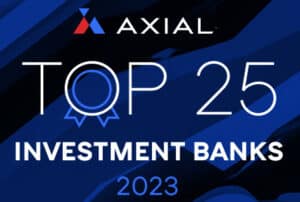
Ed Peters, keynote speaker at the June 22nd FOCUS Workshop, “MAXIMIZING WEALTH: Liquidity Strategies for Business Owners,” presented a fascinating personal account of how he sold DataDirect Technologies for $88 million.
According to Washington Business Journal, ”After tackling a startup venture, then leaving the business for a time, Ed Peters returned with a bang to lead a buyout … the 50-year-old former CEO of Rockville-based DataDirect Technologies … came back after a two-year leave to take the software company through a successful buyout in 2001 that spun it off from another business … Peters turned the company into a money maker, and after two years of profitable growth sold it for $88 million to become an operating unit of Bedford, MA-based Progress Software.”
Ed Peters is the recipient of many awards including the 2004 Maryland Technology Council Entrepreneur of the Year. In the article below entitled, “SELLING YOUR COMPANY: Lessons Learned Along the Way,” Ed Peters candidly describes his experiences during the transaction as well as the five practical lessons he learned.
It was September 2001. I had just led a management buyout (along with Golden Gate Capital) that acquired DataDirect from MERANT. We had put all our wealth – as well as some wealth we probably didn’t have – into acquiring the business. Then, the unimaginable happened! After September 11th, we stayed focused and were able to complete the transaction and build a business captured some significant value. Despite the recession and other events that transpired, we were confident we’d be able to grow the business and establish value with it. And that’s what we did. Here are the lessons I learned along the way.
LESSON ONE: Always Begin with the End in Mind
What are you trying to accomplish with this business? Is it a strategic sale? Are you thinking about selling your business to somebody with a framework that will help it grow? Is somebody going to be able to leverage the distribution channels? Do you want to acquire other companies or other product to put into your distribution channel?
Do you think you will be able to take the business public? Can you grow it fast enough? Can you grow it to a sufficient size so that you are able to take the public’s money and manage it with trust? There are a number of companies that did go public during the Internet bubble that were trading for a long time at or below their cash values. Should those have been public companies? No. They should have been strategic sales. If you want to go public with a company, there’s an entirely different process you need to start thinking about.
The third option is to just run the business for cash, borrowing some money and every once in a while recapitalizing the debt. It is like borrowing money on your house and taking cash out of it that way. That is a very valid business strategy. The question is, what is it you want to do?
You have more options than you think. What do you have in mind? Are you going to declare dividends on the business, paying them out regularly or only after a recap? All these things can provide value to you, as well as your investors. The question is, what do you want?
In the beginning, start thinking about how you’re going to manage the business. Consider what cycles you’re going to take it through and how you’re going to get it there.
LESSON TWO: Develop a Process and Stay the Course
How are you going to get from point A to point B? If you just muddle through from point A to point B, you may be lucky and you may get there, but chances are you won’t. Chances are you’ll have more opportunity to fail than you will to succeed. Think about the process you’re going to go through and how you’re going to get there.
In our case, we acquired a business from another company so we focused on the first step, extraction. In some episodes of Star Trek, they would separate the battle saucer from the rest of the ship and then try to fly it. Sometimes it flew and sometimes it crash landed. That’s the best analogy I can give you for extraction. You’re attached to the mother ship and then suddenly pull this piece away and you must fly on your own—or crash. It is a very risky part of the process and everything needs to work correctly or failure can come quickly.
The first six months of operation after a buyout from a large organization is what we call the extraction. Why is it so difficult? In our case, we had never managed a customer base by ourselves. That was always done by the corporate function of the previous owner. Second, we never collected money by ourselves, running our own financial administrative systems.
In the extraction phase, it is zero percent boredom, 10 percent euphoria and 90 percent abject terror because you have no idea if people are going to pay you. Why are they going to pay you? They paid the parent company for all these years, but now are they going to stick with you? Are they going to go to your competitors? Are your salesmen going to show up? Are they going to perform? You’ve entered this big zone of uncertainty.
In the extraction phase, you need to focus on your ability to generate and retain cash. Once you’ve successfully navigated the first six months, you move into the optimization phase which lets you focus on running the business profitably. You start to grow the top and bottom line in repeatable fashion.
We decided to take two years to grow the business, top and bottom line, in a repeatable fashion. Why? Remember lesson number one: begin with the end in mind. We never felt that we had the opportunity to become a public company. We did believe that we had the opportunity to have a strategic sale. If this is going to be an option, we needed a track record of solid growth in both areas. You need to be able to show that you are both creating and capturing value. This is the optimization period.
After we acquired the business, we took the revenue down and took the earnings up. Some of the revenue in the business was unprofitable and we got rid of it. Get rid of unprofitable parts of the business. Once you acquire a business, focus on being objective about its parts and don’t fall in love with any one of them. In order to have a healthy operation, your mission is about running a business profitably. Again, remember lesson one: begin with the end in mind.
Your best interest is to have a really highly profitable and productive machine that you’re selling to somebody else that has no potential for a drag on their earnings but will pop value in from day one. That’s your objective. So we took the revenue down. We took it back up by approximately five percent in 2002, and then by nearly five percent again in 2003. All the time we were driving the bottom line up by double digit percentages.
Now, if you’re an acquirer, what’s that look like to you? It looks wonderful because what you believe is, “Gee, I have a bigger channel than they have. I can pop that top line back and guess what? There’s probably another three to $4 million of potential EBITDA there for me because we eliminate some of the redundancies in the two businesses.” That’s a great story you can take to the market any day!
LESSON THREE: All Bankers are Not Created Equal
Not all investment bankers are created equal. You may think it would be wonderful to be represented by a big name bank. Wouldn’t that be great? Is that good or bad? It depends on the value of the transaction.
If a big bank thinks you have a huge deal — half a billion dollars and up — then they might be really interested in your deal. But if they take your deal and you’re less than $100 million, guess who is going to show up as the day-to-day person on your deal? Probably somebody who’s not even gone to B-school yet — somebody who may be doing your deal just to get some experience under their belt. What is this banker going to do for you?
Who is going to work with you on the transaction? Is it somebody senior enough to whom you are important? Is it somebody who is going to work with you to get the transaction finished? Is it somebody who understands your market and is going to do the research and who is going to help you write the book? This is a huge process you’re undertaking, and not all the banks are equal.
We interviewed the top 20 investment banks in the country. We probably met with seven of them, running them through an interview process. The most important question you need to ask is: “What is the banker’s record of success with the potential acquirers of your business?”
If your deal is going to be their first time in a particular segment, your success ratio is moving down the scale here. What are their typical transactions? Whom do they typically represent? What is their success ratio in this type of business?
Are they experienced enough to be working with your business? Are the people who meet with you going to be the people who work with you? Or are you going to get the 24-year-old who is going to make some phone calls and hope that something happens?
All investment bankers are not all created equal. You need to interview the full range, and then decide who fits your business based upon the end you have in mind and the process you’ve just run through to get there. All of this is critical. And what have they done with your target lately?
Now, I actually did my own market research and figured out the top five people who would acquire the company. That doesn’t mean that we didn’t need the bankers. Absolutely not. The bankers were a critical part of the deal because they actually verified our thinking and had 20 other people that we never thought of. The bankers run the process. The bankers focus on the deal. The bankers help you get something done.
As a matter of fact, I wouldn’t recommend buying or selling a business without a banker, or without the other side having a banker, too. A banker can tell you what the logical valuation range is going to be. They can show you what you might expect given certain variables in the process, and explain it to you in such a way that your expectations are properly set.
If you think your business is worth $200 million and the buyer thinks it is worth $60 and the banker tells you, “Yes, he’s about right. Maybe it is $70.” The banker is probably right. They understand the market. They spend the time on the research and understand the valuations.
Also, can the bank get the deal closed within a six-month window? If you don’t get it done within a six-month window, the acquirer may say, “There must be something wrong with this deal.” Then what happens? Your valuation starts moving down.
Does the bank have a process showing timeframes outlined for you? Can they get it done for you on time? Choose the right banker for your situation. Make sure they have a process. Make sure they understand your relative types of buyers and make sure they are mature enough to get something accomplished.
LESSON FOUR: Eat When Served
A personal story illustrates this lesson. I was working with a start-up company where the founders wanted $200 million, and the board thought that sounded good to them, too. The potential acquiring firm put $60 million on the table. The Board debated it and said, “No, we’d like to get at least a hundred for this.” They were not working with a banker. “We should hold out for a hundred.” They turned down the $60 million and about a year later they shuttered the business. But I remember one board member — who was overruled — saying, “My philosophy, boys, is eat when served.”
If someone is willing to put up $60 million for the business and the banker tells you, “Yes, that’s in the range,” and you’ve committed to doing it, then it is time to move on. Eat when served. Have realistic expectations about what your business is worth. That’s where the bankers can help you by truly showing you why a business is worth a specific value range.
Also, I recommend that you retain your own counsel. Yes, it’s your business. Yes, people are looking out for you. But at the end of the day, everybody now is focused on the success of the transaction. Make sure somebody is looking at your issues and also is going to be able to explain it to you.
One day a lot of money shows up in your account. You’re thrilled, but the job is not done. First, you need to prepare your staff to succeed in the new environment. You’re not finished until that’s completed. They need to understand the culture and they need to know how to work in the new environment.
Make sure that you put all your efforts into helping them achieve success in integrating into the new environment. Make sure that their plan for the next year has your stamp on it. You don’t want your key people leaving, because the whole issue of leadership is about trust. All these years they’ve trusted you and you have succeeded together.
Make sure that you stay personally and guide that ship through that first six months, or longer if you can, to ensure its success; to ensure that all the pieces line up and to ensure that all the rough spots can be addressed. Lastly, step away with grace and let the new owners succeed now on their own. You wish them all the best and help them go forward.
CONCLUSION
Always remember to begin with the end in mind. From the beginning, know exactly what you’re trying to accomplish. Develop a process and stay the course. Manage the process yourself from end to end. Understand why you’re utilizing the services of an investment banker as well as exactly why you’re selecting a particular banker. Promise yourself to eat when served. And, keep your expectations realistic. If you’re committed to selling the business, take the best deal on the table and move forward. And finally, finish the job. It is your responsibility to make sure that the acquirer succeeds with the business.












